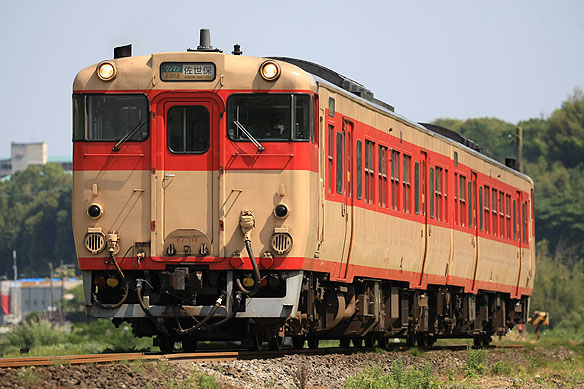Background and overview
In 1975, Japanese National Railways (JNR) developed two-car diesel multiple unit (DMU) train, kiha66 series to deliver for rapid services in north Kyushu region, before the start of the operations on the Sanyo Shinkansen between Okayama and Hakata. The standard formation of kiha66 series is 2-car formation by a kiha66 single-ended vehicle and a kiha67 single-ended vehicle.
Car body
They have 20806mm long and 2930mm wide body. Their body design incorporates lightweight shaped steel and pressed forming beam to realize a lightweight body. Their body skin features weatherproof high-tension steel sheet. The original design was closely based on the class kiha65 DMU, with the primary difference being cabs that were 150 mm higher for safety against crossing accidents. They incorporate 2 double-leaf automatic doors, 4 pairs of 715mm wide double-hung unit assembled side windows, the upper sash of which moves down and the lower moves up, and door case windows between the doors, and a pair of 715mm wide double-hung unit assembled windows and a door case window at either end of the body on each side of the vehicles. Door operating equipments, TK106, are fitted above the doorways. Destination indicator screens are fitted on the side of the body. An air conditioner, AU75CM rated at 37,000kcal/h, is fitted on the centre of their roof. forced ventilators are fitted on both sides of the air conditioner. In addition, they are equipped with an exhaust pipe of the prime mover inside the driver's cab and an exhaust pipe of the power generator inside the wall at the rear of the vehicle. They employed tight lock automatic couplers having the rubber draft gear, RD13. Their livery is cream with scarlet wide band around side windows, narrow scarlet skirting, and narrow scarlet gutter.
Bogies
The powered bogies are DT43 incorporating 2-axle drive, trailer bogies are TR226. These bogies incorporate bolster anchors and a center pivot for the traction device, parallel link journal box supporting system, and air springs mounted to the body directly. A propeller shaft penetrates the opening of the bogie transom to realize 2-axle drive. The gear ratio of powered bogies is 2.995. The bogie apply employs single tread brake rigging.
Traction unit and ancillary equipments
They are powered by a four-cycle 180 V12-cylinder diesel prime mover, DML30HSC, with a power output of 440PS employing a turbocharger powered by the flow of exhaust gas. This prime mover features the cylinder head is changed into individual from monoblock covering 3 cylinders. They are equipped with a belt drive radiation fan beneath the floor and a hydrostatic radiation fan on the roof for a prime mover. The hydraulic transmission gear, DW9, employs a three-member single-stage torque converter, a multi-plate wet clutch to select the direct stage manually, and the filling and draining of the hydrodynamic circuit. Class kiha67 vehicles are equipped with a power generator unit consisting of a diesel engine, 4VK, with a power output of 90PS and generator, DM83, with a power output of 70kVA beneath the floor. Each vehicle is equipped with a water-cooled air compressor, CW750D, powered by a prime mover. The brake system is the automatic electromagnetic (CLE) air brake with the load compensating device.
Accommodation
They have a mixture of longitudinal bench seating located beside doors and at the end of the passenger saloon and switchable transverse seating, W15N, with 910mm seating pitch. The pillow of transverse seating is covered with artificial leather. Class kiha66 is equipped with a Japanese style toilet located at the rear of the body with the preparation to be fitted with a chemical holding tank.
Modifications
Replacement of a traction unit and ancillary equipments
A superannuated prime mover received the modifications with the replacement with DMF13HZA with a power output of 450PS, a hydraulic transmission with DW14H, a power generator with SIC-COS90, and the removal of a hydrostatic radiation fan on the roof over the period from December 1993 until March 2001.
Kiha66-100 series
A propeller shaft and a bogie of kiha66 and kiha67, the propeller shaft of which had fallen, were replaced over the period from March 2011 until March 2013 and they were classified into -100 subclass. A new bogie was still classified into DT43.
Operations
They were delivered to Nogata depot and entered "Hita" and "Handa" express services besides the rural and rapid servcies on the Chikuho and Sasaguri lines in 1975. Express services were discontinued in 1980. However, they had been used on the rural services on the Chikiho and Sasaguri lines after splitting the former JNR into the new privatized JR companies in 1987.
However, they were reallocated to Nagasaki depot to enter "Seaside line" rapid services and rural services on the Omura and Nagasaki lines with the change into Seaside liner livery at the starting of the electrified Chikuho and Sasaguri lines in 2001. Eventually, they began to be replaced with YC-1 series DMU in 2020 and finally had completely withdrawn from revenue services in 2021. And now only one two-car set remains. |
|





